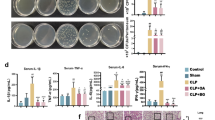Abstract
Rat peritoneal macrophages in vitro were infected with Mycobacterium tuberculosis and the fate of M. tuberculosis inside macrophages was monitored. Alteration in the levels of nitric oxide (NO) measured in terms of nitrite formed, hydrogen peroxide (H2O2) and lysosomal enzymes such as acid phosphatase, cathepsin-D and β-glucuronidase in macrophages following M. tuberculosis infection was also studied. Elevation in the levels of nitrite were observed from 72 h of M. tuberculosis infection. Irrespective of the time point, M. tuberculosis infected macrophages produced elevated levels of H2O2. Maximum increase in the level of acid phosphatase was observed from 72 h of M. tuberculosis infection, whereas maximum elevation in the level of β-glucuronidase was observed 48 h after M. tuberculosis infection. However these microbicidal agents did not alter the intracellular viability of M. tuberculosis. (Mol Cell Biochem 175: 169–175, 1997)
Similar content being viewed by others
References
Glassroth J, Robins AG, Snider DE: Medical progress in tuberculosis in the 1980s. New Eng J Med 302: 1441–1443, 1980
Pitchemick AE, Bun J, Laufer M, Miller G, Cocciatore R, Bigler WJ, Witte J, Cleary T: Outbreaks of drug resistant tuberculosis at AIDS center. Lancet 336: 440, 1990
Chaparas SD: Immunity in tuberculosis. Bull World Health Organization 60: 447–462, 1982
Barret AJ, Heath MF: Lysosomal enzymes. In: T Dingle (ed). Lysosomes – A Laboratory Hand Book. 1977, pp 110–115
Kawai Y, Anno K: Mucopolysaccharide-degrading enzymes from the liver of squid, Ommastrephes sloanipacifers. Biochim Biophys Acta 242: 428–436, 1971
Sapolsky AI, Altman RD, Howell DS: Cathepsin D activity in normal and osteoarthritic human cartilage. Fedn Proc 32: 1489–1493, 1973
Lowry OH, Rosebrough NJ, Faer AL, Randell RJ: Protein measurement with the folin phenol reagent. J Biol Chem 193: 265–275, 1951
Pick E, Mizel D: Rapid microassays for the measurement of superoxide and hydrogen peroxide by cells in culture using an automatic enzyme immunoassay reader. J Immunol Meth 46: 211–214, 1981
Ding AJ, Nathan CF, Stuchr DJ: Release of reactive oxygen intermediates from mouse peritoneal macrophages: Comparison of activating cytokines and evidence for independent production. J Immunol 141: 2407–2412, 1988
Dennis M: Killing of M. tuberculosis within human monocytes: Activation by cytokines and calcitriol. Clin Exp Immunol 84: 200–206, 1991
Warwick JD, Dhillon DJ, Obrien L, Andrew PW, Lowrie DB: Apparent killing of M. tuberculosis by cytokine activated human monocytes can be artefact of a cytotoxic effect on the monocytes. Clin Exp Immunol 96: 214–221, 1994
Chan J, Xing Y, Magliozzo RS, Bloom BR: Killing of virulent M. tuberculosis by reactive nitrogen intermediates produced by activated murine macrophages. J Exp Med 175: 1111–1122, 1992
Andrew PW, Jackett PS, Lowrie DB: Killing and degradation of microorganisms by macrophages. In: Dean, Jessup (eds). Mononuclear Phagocytes: Physiology and Pathology. 1985, pp 311–334
Rhodes JM, Nielson G, Olesen Larsen S, Bennedsen J, Riisgard S: In vitro studies on normal, stimulated and immunologically activated mouse macrophages. II. Degradation of radioactive antigen/antibody complexes. Acta Pathol Microbiol Scand 85: 239–245, 1977
Pantalone RM, Page RC: Lymphokine induced production and release of lysosomal enzymes by macrophages. Proc Nat Acad Sci 72: 2091–2094, 1975
Ando M, Suga M, Shima K, Sugimoto M, Higuchi S, Tsuda T, Jukusmi H: Different effects of phytohaemagglutinin activated lymphocytes and their culture supernatant on macrophage function. Infect Immun 13: 1442–1448, 1976
Sorber WA, Leake ES, Myrvik QN: Comparative densities of hydrolase containing granules from normal and BCG induced alveolar macrophages. Inf Immun 7: 86–92, 1973
Dannenberg AM, Ando M, Rojas-Espinosa O, Shimo K, Tsudo T: Macrophage activation in tuberculosis lesion. In: WH Wagner, H Habu (eds). Activation of Macrophages. Excerpta Medica and American Elsevier, Amsterdam and New York, 1979, pp 223–235
Lowrie DB, Andrew PW, Peters TJ: Analytic fractionation of subcellular organelles from the pulmonary alveolar macrophages of normal and BCG vaccinated rabbits. Biochem Soc Trans 5: 1458–1460, 1977
Stahelin H, Karnovsky MK, Suter E: Studies on the interaction between phagocyte and tubercle bacilli. II. Action of phagocytes upon 14C labelled tubercle bacilli. J Exp Med 104: 137–150, 1956
Rees RJW, Hart PDA: Analysis of the host parasite equilibrium in chronic murine tuberculosis by total and viable bacillary counts. Br J Exp Path 42: 83–88, 1961
Walker L, Lowrie DB: Killing of Mycobacterium microti by immunologically activated macrophages. Nature 293: 69, 1981
Murray HW, Rubin RY, Carriero SM, Harris AM, Jaffee EA: Human mononuclear phagocyte anti protozoal mechanisms: Oxygen-dependent versus oxygen independent activity against intracellular Toxoplasma gondii. J Immunol 134: 1982, 1985
Rothermal CD, Rubin BY, Jaffe EA, Murray HW: Oxygen independent inhibition of intracellular Chlamydia psittaci growth by human monocytes and interferon activated macrophages. J Immunol 137: 689, 1986
Flesch IEA, Kaufmann SHE: Attempts to characterize the mechanisms involved in mycobacterial growth inhibition by gamma interferon activated bone marrow macrophages. Infect Immun 56: 1464, 1988
Scott P, James S, Sher A: The respiratory burst is not required for killing of intracellular and extracellular parasites by a lymphokine activated macrophage cell line. Eur J Immunol 15: 553, 1985
Hibbs JB: Synthesis of nitric oxide from L. arginine a recently discovered pathway induced by cytokines with antitumour and antimicrobial activity. Res Immunol 142: 565–569, 1991
Drapier JC: L. arginine derived nitric oxide and cell mediated immune response. Res Immunol 142: 553–555, 1991
Granger DL: Macrophage production of nitrogen oxide in host defence against microorganism. Res Immunol 142: 570–572, 1991
Author information
Authors and Affiliations
Rights and permissions
About this article
Cite this article
Vishwanath, V., Meera, R., Narayanan, P.R. et al. Fate of Mycobacterium tuberculosis inside rate peritoneal macrophages in vitro. Mol Cell Biochem 175, 169–175 (1997). https://doi.org/10.1023/A:1006848900722
Issue Date:
DOI: https://doi.org/10.1023/A:1006848900722




